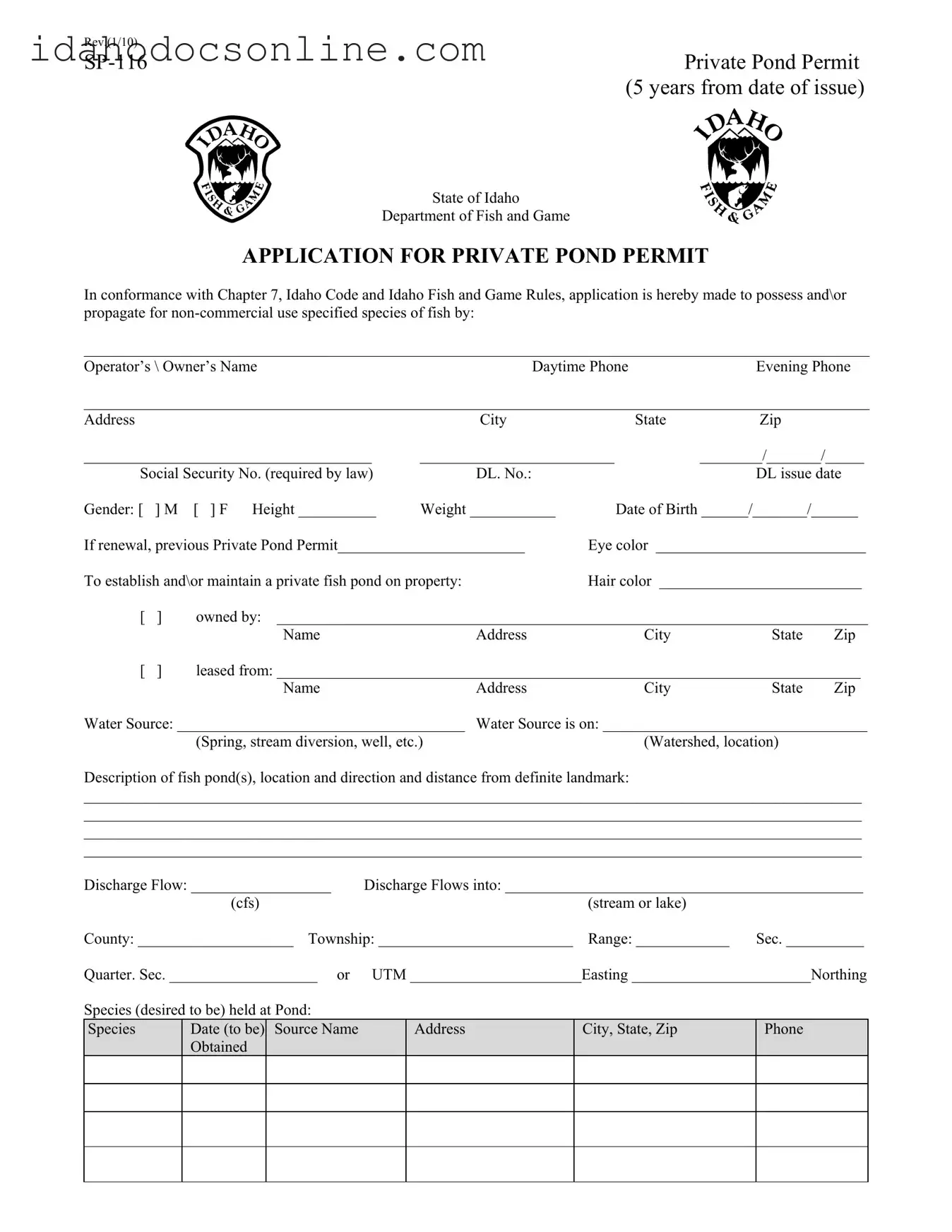Rev.(1/10) |
|
SP-116 |
Private Pond Permit |
|
(5 years from date of issue) |
State of Idaho
Department of Fish and Game
APPLICATION FOR PRIVATE POND PERMIT
In conformance with Chapter 7, Idaho Code and Idaho Fish and Game Rules, application is hereby made to possess and\or propagate for non-commercial use specified species of fish by:
_____________________________________________________________________________________________________
Operator’s \ Owner’s NameDaytime PhoneEvening Phone
_____________________________________________________________________________________________________
Address |
|
|
|
City |
State |
Zip |
|
_____________________________________ |
_________________________ |
________/_______/_____ |
Social Security No. (required by law) |
DL. No.: |
|
DL issue date |
Gender: [ |
] M |
[ ] F |
Height __________ |
Weight ___________ |
Date of Birth ______/_______/______ |
If renewal, previous Private Pond Permit________________________ |
Eye color ___________________________ |
To establish and\or maintain a private fish pond on property: |
Hair color __________________________ |
[ |
] |
owned by: ____________________________________________________________________________ |
|
|
|
Name |
Address |
City |
State |
Zip |
[ |
] |
leased from: ___________________________________________________________________________ |
|
|
|
Name |
Address |
City |
State |
Zip |
Water Source: _____________________________________ Water Source is on: __________________________________
(Spring, stream diversion, well, etc.)(Watershed, location)
Description of fish pond(s), location and direction and distance from definite landmark:
____________________________________________________________________________________________________
____________________________________________________________________________________________________
____________________________________________________________________________________________________
____________________________________________________________________________________________________
Discharge Flow: __________________ |
Discharge Flows into: ______________________________________________ |
|
(cfs) |
|
|
(stream or lake) |
|
County: ____________________ Township: _________________________ |
Range: ____________ |
Sec. __________ |
Quarter. Sec. ___________________ or |
UTM ______________________Easting _______________________Northing |
Species (desired to be) held at Pond: |
|
|
|
|
Species |
Date (to be |
) |
Source Name |
|
Address |
City, State, Zip |
Phone |
|
Obtained |
|
|
|
|
|
|
|
|
|
|
|
|
|
|
|
|
|
|
|
|
|
|
|
|
|
|
|
|
|
|
|
|
|
|
|
|
|
|

Page 2
Private Pond Permit Application (continued)
36-706. PRIVATE PARKS AND PONDS -- NONCOMMERCIAL -- PERMIT REQUIRED. No person shall establish and maintain a private park or pond on premises owned or leased by him and obtain, possess, transport, propagate and process for his own personal pleasure and use any fish approved by the commission, or any big game animals found wild in this state unless he has first obtained a permit from the director. (a) Permit Requirements. Such permit may be issued by the director upon his finding that: 1. Such private park or pond is not constructed in or across any natural stream bed, lake, or other watercourse containing wild fish, or on lands where wildlife abounds, except when it has been determined by the commission that the water flow and volume of wildlife concerned in such proposed private ponds, waters or parks are not a significant part of the wildlife resource of the state. 2. The private park or pond is located entirely on private property owned or leased by the applicant. 3. Any dam constructed to divert water into such private pond meets all requirements as provided in section 36-906(a), Idaho Code. 4. All inlets to such private pond are screened at the point of diversion as provided in section 36-906(b), Idaho Code, to prevent the entrance of wild fish into the private pond. 5. The application for such permit is made upon a form provided by the department which sets forth such information as may be required by the director. 6. The lands proposed for use as a park are so fenced as to prevent the escape of private wildlife therefrom and prevent the entry thereon of publicly owned big game animals. 7. Said park or pond shall be posted in three
(3)separate conspicuous places and all entrance roads. (b) Separate Locations -- Permits Required. Such a park or pond permit must be had for each and every location. A pond permit shall expire on June 30 of the fifth fiscal year after the date of issuance.
APPLICATION CERTIFICATION
I hereby certify that the information submitted in this application is complete and accurate to the best of my belief. I understand that any false statement herein may subject me to criminal prosecution.
____________________________________________________ |
________________________________ |
Signature |
Date |
IDAHO DEPARTMENT OF FISH & GAME, OFFICIAL USE ONLY
INSPECTION CHECK LIST FOR PRIVATE FISH PONDS
1. |
Inlet screen adequate to prohibit fish movement? |
|
Yes |
|
No |
2. |
Outlet screen adequate to prohibit fish movement? |
|
Yes |
|
No |
3.What species are currently in the pond? ____________________________________________________
_____________________________________________________________________________________
4. Should permit be granted based on this inspection? Yes No
Date of Inspection _______________ Officer Signature _____________________________________
Private Pond Permit No.: ________________________
Expires June 30 _____________
Date issued: ______________ issued by: ___________
Department of Fish and Game
Virgil Moore, Director
Approved by: _______________________________________
Signature


